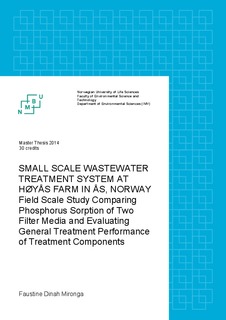| dc.contributor.author | Mironga, Faustine Dinah | |
| dc.date.accessioned | 2014-08-04T12:28:51Z | |
| dc.date.available | 2014-08-04T12:28:51Z | |
| dc.date.copyright | 2014 | |
| dc.date.issued | 2014-08-04 | |
| dc.identifier.uri | http://hdl.handle.net/11250/216666 | |
| dc.description | Wastewater Samples were taken from Høyås Small Scale Wastewater Treatment System and Analysed for phosphorus, nitrogen, biochemical oxygen demand, pH, conductivity, and bacteria. Phosphorus sorption in Filtralite P and Filtramar were compared using t-test. | nb_NO |
| dc.description.abstract | Phosphorus (P) removal in small scale wastewater treatment systems (SSWWTSs) to achieve P discharge limit of 1mg/l requires P filters with high P sorption capacity. For comparison purposes, two P filters are used at Høyås SSWWTS. The system comprises of a septic tank and biofilter for pre-treatment. This is followed by two P filter units installed parallel to each other where one is filled with P filter Filtralite® P (PFFP) while the other with P filter Filtramar® (PFFM) also called Shellsand. Finally, two sand filter units are also installed parallel to each other as a polishing step. One sand filter (SFFM) receives effluent from PFFM and the other sandfilter (SFFP) receives PFFP effluent. This work compared P sorption capacity between PFFP and PFFM. This is by taking WW samples from effluent in each treatment unit and analyse for P in form of total P (TP) and orthophosphate (Ortho-P). At the same time, the general treatment performance and effect of replacing insulating tree bark with light weight aggregates (LWA) (Leca® ISO 10-20mm) was monitored. The tree bark leached organic substances into treatment components and this changed WW effluent colour. The colour changes were monitored before and after tree bark replacement.
Treatment performance other than phosphorus was monitored by analysing for nitrogen (N) in form of total nitrogen (TN), ammonium ions (NH4+), and nitrates, as well as 5-day biochemical oxygen demand (BOD5), conductivity, and pH. In addition, one-time sample was taken and analysed for bacteria. The comparison of P sorption was described by t-test that showed that PFFP has higher P sorption capacity than PFFM at 95% confidence level. Regarding treatment performance, the Høyås system has a removal efficiency of >95% for TP, >95% for Ortho-P, 50-60% for TN, 65-80% for NH4+, and >98% for BOD.
The final effluent has mean TP effluent concentration of 0.6mg/l and 0.95mg/l from SFFP and SFFM respectively and mean BOD concentration of 3.8mg/l and 3mg/l from SFFM and SFFP respectively. The treatment system meets the discharge limits of 1mg/l for P and 20mg/l for BOD set by the Ås municipality. Organic substances from tree bark affected WW colour. WW effluent from treatment components had a yellow-brown colour before tree bark replacement and became clearer after tree bark replacement. Replacing tree bark showed a positive effect on P and BOD treatment performance. The one-time sampling of bacteria shows that the final effluent has 31 E. coli/100ml and 13E. Coli/100ml from SFFM and SFFP respectively, hence, the treatment system meets the European standard for swimming water of <500E. Coli/100ml. | nb_NO |
| dc.language.iso | eng | nb_NO |
| dc.publisher | Norwegian University of Life Sciences, Ås | |
| dc.subject | Phosphorus Sorption, Filtramar, Filtralite P | nb_NO |
| dc.subject | VDP::Landbruks- og Fiskerifag: 900::Landbruksfag: 910 | nb_NO |
| dc.title | Small Scale Wastewater Treatment System at Høyås Farm in Ås, Norway | nb_NO |
| dc.type | Master thesis | nb_NO |
| dc.source.pagenumber | 77 | nb_NO |
| dc.description.localcode | M-MINA | nb_NO |
